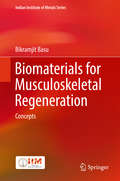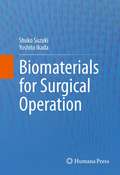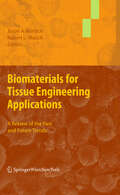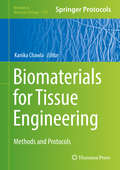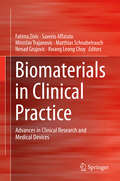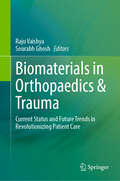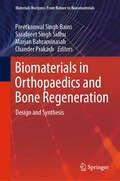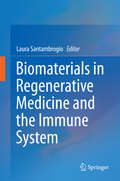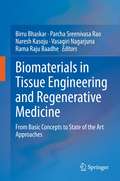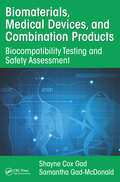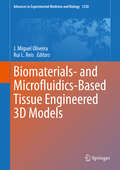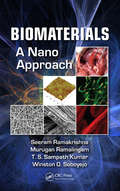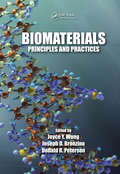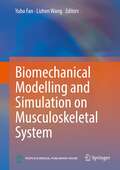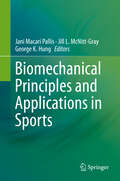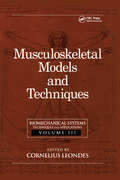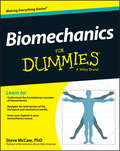- Table View
- List View
Biomaterials for Musculoskeletal Regeneration: Concepts (Indian Institute of Metals Series)
by Bikramjit BasuThis book covers the basics of the biomaterials science its applications to bone tissue engineering. The introductory section describes the most necessary concepts and techniques related to the cell and molecular biology with a particular focus on evaluating the biocompatibility property. The layout of this book facilitates easier understanding of the area of bone tissue engineering. The book integrates the Materials Science and Biological Science. It covers processing and basic material properties of various biocompatible metals and ceramics-based materials, in vitro and in vivo biocompatibility and toxicity assessment in the context of bone tissue engineering, and processing and properties of metal-, ceramic- and polymer-based biocomposites, including the fabrication of porous scaffold materials. The book can be used as a textbook for senior undergraduate and graduate coursework. It will also be a useful reference for researchers and professionals working in the area.
Biomaterials for Surgical Operation
by Yoshito Ikada Shuko SuzukiBiomaterials for Surgical Operation offers a review of the latest advances made in developing bioabsorbable devices for surgical operations which include surgical adhesives (sealants), barriers for the prevention of tissue adhesion, polymers for fractured bone fixation, growth factors for the promotion of wound healing, and sutures. Over the years, many descriptions of biomaterials have appeared in academic journals and books, but most of them have been devoted to limited clinical areas. This is in marked contrast with this volume which covers a wide range of bioabsorbable devices used in surgery from a practical point of view. The currently applied polymeric devices are critical in surgery, but all involve serious problems due to their poor performance. For instance, fibrin glue, the most widely used surgical sealant, can produce only a weak gel with low adhesive strength to tissues, accentuating the limited effectiveness of current treatment options. Likewise, the currently available barrier membranes cannot fully prevent tissue adhesion at the acceptable level and are, moreover, not easy to handle with endoscopes due to their poor mechanical properties. Biomaterials for Surgical Operation is aimed at those who are interested in expanding their knowledge of how the problems associated with the currently used devices for surgical operation can be solved. It primarily focuses on the absorbable biomaterials which are the main components of these medical devices.
Biomaterials for Tissue Engineering Applications: A Review of the Past and Future Trends
by Robert L. Mauck Jason A. BurdickA concise overview of tissue engineering technologies and materials towards specific applications, both past and potential growth areas in this unique discipline is provided to the reader. The specific area of the biomaterial component used within the paradigm of tissue engineering is examined in detail. This is the first work to specifically covers topics of interest with regards to the biomaterial component. The book is divided into 2 sections: (i) general materials technology (e.g., fibrous tissue scaffolds) and (ii) applications in the engineering of specific tissues (e.g., materials for cartilage tissue engineering). Each chapter covers the fundamentals and reflects not only a review of the literature, but also addresses the future of the topic. The book is intended for an audience of researchers in both industry and academia that are interested in a concise overview regarding the biomaterials component of tissue engineering, a topic that is timely and only growing as a field.
Biomaterials for Tissue Engineering: Methods And Protocols (Methods In Molecular Biology #1758)
by Kanika ChawlaThis volume provides protocols for the generation of various biomaterials for tissue engineering and regenerative medicine applications. The chapters in this book include a look at a range of biomaterials including hydrogels and other matrices (natural, synthetic, self-healing) for various applications including drug and gene delivery, surface modification and functionalization of biomaterials. In addition, techniques described include those for controlling biomaterial geometry, such as three-dimensional printing and electrospinning. Written in the highly successful Methods in Molecular Biology series format, chapters include introductions to their respective topics, lists of the necessary materials and reagents, step-by-step, readily reproducible laboratory protocols, and tips on troubleshooting and avoiding known pitfalls.Cutting-edge and thorough, Biomaterials for Tissue Engineering: Methods and Protocols is a valuable resource for scientists and engineers interested in this vital field of study.
Biomaterials for Tissue Regeneration: Advances and Challenges for Fabrication and Clinical Translation (SpringerBriefs in Materials)
by Mohammad M. Farag Zainab M. Al-RashidyThis book comprehensively reviews the essential characteristics of biomaterials and their designs important for applications in tissue regeneration. It delves into both past research milestones in tissue engineering and emerging trends poised for future integration. The primary focus lies on the evolution of biomaterial generations and the burgeoning domain of tissue engineering discovery. Furthermore, it examines various biomaterial categories, including bioceramics, bioactive glasses, synthetic and natural polymers, alongside their composite derivatives, all pivotal in scaffold fabrication, a cornerstone of tissue engineering. The book also looks at diverse scaffold fabrication methodologies, providing readers with a thorough understanding of the technical intricacies involved. The book showcases recent breakthroughs in tissue engineering across multiple fronts such as bone, skin, cartilage, neural, and cardiac regeneration, highlighting their potential as pre-clinical interventions for rehabilitating injured or diseased tissues and organs. Finally, it reviews the contemporary landscape of biomaterials for tissue regeneration, shedding light on emerging trends and confronting the challenges that lie ahead.
Biomaterials in Clinical Practice: Advances in Clinical Research and Medical Devices
by Fatima Zivic Nenad Grujovic Saverio Affatato Miroslav Trajanovic Matthias Schnabelrauch Kwang Leong ChoyThis book covers the properties of biomaterials that have found wide clinical applications, while also reviewing the state-of-the-art in the development towards future medical applications, starting with a brief introduction to the history of biomaterials used in hip arthroplasty. The book then reviews general types of biomaterials - polymers, ceramics, and metals, as well as different material structures such as porous materials and coatings and their applications - before exploring various current research trends, such as biodegradable and porous metals, shape memory alloys, bioactive biomaterials and coatings, and nanometals used in the diagnosis and therapy of cancer. In turn, the book discusses a range of methods and approaches used in connection with biomaterial properties and characterization - chemical properties, biocompatibility, in vivo behaviour characterisation, as well as genotoxicity and mutagenicity - an d reviews various diagnostic techniques: histopathological analysis, imagining techniques, and methods for physicochemical and spectroscopic characterization. Properties of stent deployment procedures in cardiovascular surgeries, from aspects of prediction, development and deployment of stent geometries are presented on the basis of novel modelling approaches. The last part of the book presents the clinical applications of biomaterials, together with case studies in dentistry, knee and hip prosthesis. Reflecting the efforts of a multidisciplinary team of authors, gathering chemical engineers, medical doctors, physicists and engineers, it presents a rich blend of perspectives on the application of biomaterials in clinical practice. The book will provide clinicians with an essential review of currently available solutions in specific medical areas, also incorporating non-medical solutions and standpoints, thus offering them a broader selection of materials and implantable solutions. This work is the result of joint efforts of various academic and research institutions participating in WIMB Tempus project, 543898-TEMPUS-1-2013-1-ES-TEMPUS-JPHES, "Development of Sustainable Interrelations between Education, Research and Innovation at WBC Universities in Nanotechnologies and Advanced Materials where Innovation Means Business", co-funded by the Tempus Programme of the European Union.
Biomaterials in Orthopaedics & Trauma: Current Status and Future Trends in Revolutionizing Patient Care
by Sourabh Ghosh Raju VaishyaThe landscape of orthopaedics and trauma is rapidly evolving, driven by groundbreaking advancements in biomaterials. This book offers an in-depth exploration of the current state-of-the-art, highlighting the latest innovations and their clinical applications. The intersection of materials science and medicine has given rise to a revolutionary field: biomaterials. These engineered substances, designed to interact with biological systems, have become indispensable in orthopaedics and trauma surgery. From repairing broken bones to replacing worn-out joints, biomaterials have significantly advanced patient care and quality of life. In recent years, the focus has shifted towards bioactive and biodegradable materials. Bioactive materials, such as calcium phosphate ceramics, actively interact with bone tissue, promoting bone growth and integration. This characteristic is particularly valuable in bone grafts and tissue engineering applications. On the other hand, biodegradable materials, like polylactic acid (PLA) and polyglycolic acid (PGA), offer the advantage of being gradually absorbed by the body as the surrounding tissue regenerates. These materials are employed in various forms, including screws, plates, and bone scaffolds. This book offers a holistic view of biomaterials in orthopaedics and trauma by presenting an understanding of the fundamental properties of biomaterials and exploring their role in tissue regeneration and implant design. This comprehensive resource also delves into the future, examining emerging trends and technologies that are revolutionizing patient care and paving the way for new treatment modalities. This book is an essential guide to the exciting world of biomaterials for orthopaedic surgeons, trauma surgeons and biomedical researchers.
Biomaterials in Orthopaedics and Bone Regeneration: Design and Synthesis (Materials Horizons: From Nature to Nanomaterials)
by Sarabjeet Singh Sidhu Preetkanwal Singh Bains Chander Prakash Marjan BahraminasabThis book focuses on the recent advances in the field of orthopaedic biomaterials, with a particular emphasis on their design and fabrication. Biomimetic materials, having similar properties and functions to that of the natural tissue, are becoming a popular choice for making customized orthopaedic implants and bone scaffolds. The acceptability of these materials in the human body depends on the right balance between their mechanical and biological properties. This book provides a comprehensive overview of the state-of-the-art research in this rapidly evolving field. The chapters cover different aspects of multi-functional biomaterials design, and cutting-edge methods for the synthesis and processing of these materials. Advanced manufacturing techniques, like additive manufacturing, used for developing new biomimetic materials are highlighted in the book. This book is a valuable reference for students and researchers interested in biomaterials for orthopaedic applications.
Biomaterials in Regenerative Medicine and the Immune System
by Laura SantambrogioThe generation of tridimensional tissues, assembled from scaffolding materials populated with biologically functional cells, is the great challenge and hope of tissue bioengineering and regenerative medicine. The generation of biomaterials capable of harnessing the immune system has been particularly successful. This book provides a comprehensive view of how immune cells can be manipulated to suppresses inflammation, deliver vaccines, fight cancer cells, promote tissue regeneration or inhibit blood clotting and bacterial infections by functionally engineered biomaterials. However, long-lived polymers, such as those employed in orthopedic surgery or vascular stents, can often induce an immune reaction to their basic components. As a result, this book is also an important step towards coming to understand how to manipulate biomaterials to optimize their beneficial effects and downplay detrimental immune responses.
Biomaterials in Tissue Engineering and Regenerative Medicine: From Basic Concepts to State of the Art Approaches
by Birru Bhaskar Parcha Sreenivasa Rao Naresh Kasoju Vasagiri Nagarjuna Rama Raju BaadheThis book comprehensively explores the basic concepts and applications of biomaterials in tissue engineering and regenerative medicine. The book is divided into four sections; the first section deals with the basic concepts and different types of biomaterials used in tissue engineering. The second section discusses the functional requirements and types of materials that are used in developing state-of-the-art of scaffolds for tissue engineering applications. The third section presents the applications of biomaterials for hard and soft tissue engineering, as well as for specialized tissue engineering. The last section addresses the future prospects of nanobiomaterials, intelligent biomaterials, and 3D bioprinting biomaterials in tissue engineering and regenerative medicine. It also discusses various in vitro disease models for tissue bioengineering and regenerative medicine. As such, it offers a valuable resource for students, researchers, scientists, entrepreneurs, and medical/healthcare professionals.
Biomaterials, Medical Devices, and Combination Products: Biocompatibility Testing and Safety Assessment
by Shayne Cox Gad Samantha Gad-McDonaldBiomaterials, Medical Devices, and Combination Products is a single-volume guide for those responsible for-or concerned with-developing and ensuring patient safety in the use and manufacture of medical devices.The book provides a clear presentation of the global regulatory requirements and challenges in evaluating the biocompatibility and clinical
Biomaterials- and Microfluidics-Based Tissue Engineered 3D Models (Advances in Experimental Medicine and Biology #1230)
by Rui L. Reis J. Miguel OliveiraThis contributed volume reviews the latest advances on relevant 3D tissue engineered in vitro models of disease making use of biomaterials and microfluidics. The main focus of this book is on advanced biomaterials and microfluidics technologies that have been used in in vitro mimetic 3D models of human diseases and show great promise in revolutionizing personalized medicine. Readers will discover important topics involving biomaterials and microfluidics design, advanced processing techniques, and development and validation of organ- and body-on-a-chip models for bone, liver, and cancer research. An in depth discussion of microfabrication methods for microfluidics development is also provided. This work is edited by two truly multidisciplinary scientists and includes important contributions from well-known experts in their fields. The work is written for both early stage and experienced researchers, and well-established scientists enrolled in the fields of biomaterials, microfluidics, and tissue engineering, and is especially suited to those who wish to become acquainted with the principles and latest developments of in vitro models of diseases, such as professionals working in pharma, medicine, and engineering.
Biomaterials: A Basic Introduction
by Qizhi Chen George ThouasExplores Biomedical Science from a Unique PerspectiveBiomaterials: A Basic Introduction is a definitive resource for students entering biomedical or bioengineering disciplines. This text offers a detailed exploration of engineering and materials science, and examines the boundary and relationship between the two. Based on the author's course lectur
Biomaterials: A Nano Approach
by Winston O. Soboyejo Seeram Ramakrishna Murugan Ramalingam T .S. KumarThere are several well-known books on the market that cover biomaterials in a general way, but none provide adequate focus on the future of and potential for actual uses of emerging nanontechnology in this burgeoning field.Biomaterials: A Nano Approach is written from a multi-disciplinary point of view that integrates aspects of materials science a
Biomaterials: Principles and Applications
by Joseph D. Bronzino Joon B. ParkBiomaterials: Principles and Applications offers a comprehensive review of all the major biomaterials in this rapidly growing field. In recent years, the role of biomaterials has been influenced considerably by advances in many areas of biotechnology and science, as well as advances in surgical techniques and instruments. Comprising chapters
Biomaterials: Principles and Practices
by Joseph D. Bronzino Donald R. Peterson Joyce Y. WongMost current applications of biomaterials involve structural functions, even in those organs and systems that are not primarily structural in their nature, or very simple chemical or electrical functions. Complex chemical functions, such as those of the liver, and complex electrical or electrochemical functions, such as those of the brain and sense
Biomateriomics (Springer Series in Materials Science #165)
by Markus J. Buehler Steven W. CranfordBiomateriomics is the holistic study of biological material systems. While such systems are undoubtedly complex, we frequently encounter similar components -- universal building blocks and hierarchical structure motifs -- which result in a diverse set of functionalities. Similar to the way music or language arises from a limited set of music notes and words, we exploit the relationships between form and function in a meaningful way by recognizing the similarities between Beethoven and bone, or Shakespeare and silk. Through the investigation of material properties, examining fundamental links between processes, structures, and properties at multiple scales and their interactions, materiomics explains system functionality from the level of building blocks. Biomateriomics specifically focuses the analysis of the role of materials in the context of biological processes, the transfer of biological material principles towards biomimetic and bioinspired applications, and the study of interfaces between living and non-living systems. The challenges of biological materials are vast, but the convergence of biology, mathematics and engineering as well as computational and experimental techniques have resulted in the toolset necessary to describe complex material systems, from nano to macro. Applying biomateriomics can unlock Nature's secret to high performance materials such as spider silk, bone, and nacre, and elucidate the progression and diagnosis or the treatment of diseases. Similarly, it contributes to develop a de novo understanding of biological material processes and to the potential of exploiting novel concepts in innovation, material synthesis and design.
Biomechanical Aspects of Soft Tissues
by Benjamin Loret Fernando Manuel SimoesBiomechanics applies the laws and techniques of mechanics in the study of biological systems and related phenomena. Biomechanics uses mathematical and computational tools such as model construction of musclo-skeletal system, body fluid circulation, to aid medical diagnosis, therapeutics and surgery planning, designing of prostheses and implants or in tissue engineering. Present book targets specific topics pertaining to the biomechanics of soft tissues. Subjects addressed includes solids and multi-species mixtures as open systems: a continuum mechanics perspective; electro-chemo-mechanical couplings: tissues with a fixed electric charge and growth of biological tissues.
Biomechanical Basis Of Human Movement
by Timothy Derrick Joseph Hamill Kathleen KnutzenHelp your students understand the full continuum of human movement potential with the Fourth Edition of this rigorous--yet understandable--introductory text on the market. Focusing on the quantitative nature of biomechanics, Biomechanical Basis of Movement, Fourth Edition integrates current literature, meaningful numerical examples, relevant applications, hands-on exercises, and functional anatomy, physics, calculus, and physiology to help your students develop a holistic understanding of human movement. The book's chapters are essentially self-contained, allowing you maximum teaching flexibility in structuring your course. The Fourth Edition offers new content, new examples and applications, and online teaching and learning resources to save you time and help your students succeed.
Biomechanical Microsystems: Design, Processing and Applications (Lecture Notes in Computational Vision and Biomechanics #24)
by Vytautas Ostasevicius Giedrius Janusas Arvydas Palevicius Rimvydas Gaidys Vytautas JurenasThis book presents the most important aspects of analysis of dynamical processes taking place on the human body surface. It provides an overview of the major devices that act as a prevention measure to boost a person's motivation for physical activity. A short overview of the most popular MEMS sensors for biomedical applications is given. The development and validation of a multi-level computational model that combines mathematical models of an accelerometer and reduced human body surface tissue is presented. Subsequently, results of finite element analysis are used together with experimental data to evaluate rheological properties of not only human skin but skeletal joints as well. Methodology of development of MOEMS displacement-pressure sensor and adaptation for real-time biological information monitoring, namely "ex vivo" and "in vitro" blood pulse type analysis, is described. Fundamental and conciliatory investigations, achieved knowledge and scientific experience about biologically adaptive multifunctional nanocomposite materials, their properties and synthesis compatibility, periodical microstructures, which may be used in various optical components for modern, productive sensors' formation technologies and their application in medicine, pharmacy industries and environmental monitoring, are presented and analyzed. This book also is aimed at research and development of vibrational energy harvester, which would convert ambient kinetic energy into electrical energy by means of the impact-type piezoelectric transducer. The book proposes possible prototypes of devices for non-invasive real-time artery pulse measurements and micro energy harvesting.
Biomechanical Modelling and Simulation on Musculoskeletal System
by Yubo Fan Lizhen WangThe book involves the basic principles, methods, anatomy and other knowledge for modelling and simulation of the musculoskeletal system. In addition, abundant examples are presented in detail to help readers easily learn the principles and methods of modelling and simulation. These examples include the impact injury and clinical application of the modelling of bone and muscle. In terms of impact injury, the book introduces the biomechanical simulation of impact injury in head, spine, ankle, knee, eyeball and many other parts. With regard to clinical application, it explores the optimization of orthopaedic surgery and design of orthopaedic implants. Readers will find this is a highly informative and carefully presented book, introducing not only the biomechanical principles in the musculoskeletal system, but also the application abilities of modelling and simulation on the musculoskeletal system.
Biomechanical Principles and Applications in Sports
by Jani Macari Pallis Jill L. McNitt-Gray George K. HungThis book provides an overview of biomedical applications in sports, including reviews of the current state-of-the art methodologies and research areas. Basic principles with specific case studies from different types of sports as well as suggested student activities and homework problems are included. Equipment design and manufacturing, quantitative evaluation methods, and sports medicine are given special focus. Biomechanical Principles and Applications in Sports can be used as a textbook in a sports technology or sports engineering program, and is also ideal for graduate students and researchers in biomedical engineering, physics, and sports physiology. It can also serve as a useful reference for professional athletes and coaches interested in gaining a deeper understanding of biomechanics and exercise physiology to improve athletic performance.
Biomechanical Systems: Techniques and Applications, Volume III: Musculoskeletal Models and Techniques
by Cornelius LeondesBecause of developments in powerful computer technology, computational techniques, advances in a wide spectrum of diverse technologies, and other advances coupled with cross disciplinary pursuits between technology and its greatly significant applied implications in human body processes, the field of biomechanics is evolving as a broadly significant area. This Third Volume presents the advances in widely diverse areas with significant implications for human betterment that occur continuously at a high rate. These include dynamics of musculo-skeletal systems; mechanics of hard and soft tissues; mechanics of muscle; mechanics of bone remodeling; mechanics of implant-tissue interfaces; cardiovascular and respiratory biomechanics; mechanics of blood flow, air flow, flow-prosthesis interfaces; mechanics of impact; dynamics of man machine interaction; and numerous other areas. The great breadth and depth of the field of biomechanics on the international scene requires at least four volumes for adequate treatment. These four volumes constitute a well integrated set that can be utilized as individual volumes. They provide a substantively significant and rather comprehensive, in-depth treatment of biomechanic systems and techniques that is most surely unique on the international scene.
Biomechanics
by Cees Oomens Marcel Brekelmans Frank BaaijensThis is the first textbook to integrates both general and specific topics, theoretical background and biomedical engineering applications, as well as analytical and numerical approaches. This quantitative approach integrates the classical concepts of mechanics and computational modelling techniques, in a logical progression through a wide range of fundamental biomechanics principles. Online MATLAB-based software along with examples and problems using biomedical applications will motivate undergraduate biomedical engineering students to practise and test their skills. The book covers topics such as kinematics, equilibrium, stresses and strains, and also focuses on large deformations and rotations and non-linear constitutive equations, including visco-elastic behaviour and the behaviour of long slender fibre-like structures. This is the definitive textbook for students.
Biomechanics For Dummies
by Steve MccawA thorough explanation of the tenets of biomechanicsAt once a basic and applied science, biomechanics focuses on the mechanical cause-effect relationships that determine the motions of living organisms. Biomechanics for Dummies examines the relationship between biological and mechanical worlds. It clarifies a vital topic for students of biomechanics who work in a variety of fields, including biological sciences, exercise and sports science, health sciences, ergonomics and human factors, and engineering and applied science. Following the path of a traditional introductory course, Biomechanics for Dummies covers the terminology and fundamentals of biomechanics, bone, joint, and muscle composition and function, motion analysis and control, kinematics and kinetics, fluid mechanics, stress and strain, applications of biomechanics, and black and white medical illustrations.Offers insights and expertise in biomechanics to provide an easy-to-follow, jargon-free guide to the subjectProvides students who major in kinesiology, neuroscience, biomedical engineering, mechanical engineering, occupational therapy, physical therapy, physical education, nutritional science, and many other subjects with a basic knowledge of biomechanicsStudents and self-motivated learners interested in biological, applied, exercise, sports, and health sciences should not be without this accessible guide to the fundamentals.
